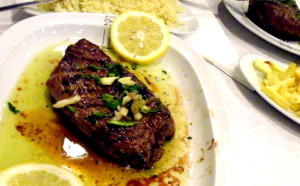Eating Lisbon up
Steer them together, and you’ll see how Lisbon’s not just made of bricks. In terms of food, well Lisbon has nothing to envy to some other Mediterranean Capitals.
 The gastronomic part of your trip to Lisbon should start right in the morning, taking a good Portuguese pequeno almoço (breakfast) made of galão (hot milk with coffee, the Portuguese version of the cappuccino) and a bolinho a little cake; you’ll get to choose among a good variety of them. The most traditional ones are the pastéis de nata (little puff pastry baskets filled with custard and sprinkled with cinnamon and icing sugar). Then, in the middle of the afternoon, you shouldn’t forget the lanche it’s the afternoon snack, usually salty, waiting for the late dinner: a torrada (a thick leaf of grilled bread with salty butter) or a croissant misto (a huge croissant filled with ham and cheese) will perfectly do.
The gastronomic part of your trip to Lisbon should start right in the morning, taking a good Portuguese pequeno almoço (breakfast) made of galão (hot milk with coffee, the Portuguese version of the cappuccino) and a bolinho a little cake; you’ll get to choose among a good variety of them. The most traditional ones are the pastéis de nata (little puff pastry baskets filled with custard and sprinkled with cinnamon and icing sugar). Then, in the middle of the afternoon, you shouldn’t forget the lanche it’s the afternoon snack, usually salty, waiting for the late dinner: a torrada (a thick leaf of grilled bread with salty butter) or a croissant misto (a huge croissant filled with ham and cheese) will perfectly do.
As for the main meals, the Portuguese typical dish is bacalhau (cod fish); they cook it in lots of ways, though maybe the ones you’ll find more frequently are Bacalhau com natas (in the oven, frayed, with cream and potatoes), Bacalhau à Bráz (fried, frayed, with eggs and potatoes) and Bacalhau à Lagareiro (in the oven with onions and peppers). Then, an interesting dish is the Carne de porco à alentejana (pork in the Alentejo way), a mixture of potatoes, pork and clams! In Lisbon caracóis (snails) are very popular, and then a variety of fish and meat. If you long for a soup, then you can ask for a caldo verde (a cabbage soup with chouriço cured spiced sausage slices) or a sopa da pedra (the name, stone soup, is based on a legend, which tells the story of a beggar who asked a lady for some hot water and a stone to make his soup. Made curious, the lady gave him what he asked, while he carried on adding ingredients to it; it ended up to be a full soup with everything the lady had in her kitchen, and that’s actually how it’s made: with all the vegetable and sausages the chef has got at his disposal!). When you’ re ready to experience some spiced chicken stomach, ask for moelas served in pieces, drowned in an abundant and spicy sauce, with bread to accompany.
Desserts: leite creme (a kind of custard, with sugar on the top and grilled) and arroz doce (sweet rice: that’s what it is! Rice cooked with milk, sugar, lemon rind and cinnamon).
Drinks: Porto wine is obviously a must, but try some vinho verde, too; after a good dinner, the licor beirão is one of the Portuguese typical liquors, together with the amêndoa amarga (almonds liquor) and, typical of Lisbon, the ginja (the beloved Lisbon’s ginginha, a black cherry liquor). If you’d like a refreshing beer, then a Super Bock will help it’s the Portuguese beer brand, along with Sagres; ask for an imperial to have a glass, caneca for a tankard; garrafa for a bottle.
Notice that as soon as you’ll sit at a table of a restaurant the waiters will bring you olives, patés, cheeses and bread without being asked you’ll pay just what you’ll eat!
Some good hotels may sometimes have gourmet restaurants inside providing guests with Portuguese delicacy and some other international dishes. The chain of Vip hotels can be a good starting point: they usually provide a central accommodation with average prices in standard rooms. In high season from June to August, for example, you can expect to spend 30-50 euros per person with breakfast and full services.
Here the list of some of them spreading all through the Portuguese Capital: the Vip Executive Zurique Hotel; Hotel Vip Executive Arts; Vip Executive Barcelona; Hotel Vip Inn Berna; Hotel Vip Executive Diplomatico; Hotel Vip Executive Suites Eden; Hotel Vip Executive Madrid; Hotel Vip Executive Suites Marques; Vip Inn Veneza Hotel; VIP Grand Lisboa Hotel and Spa.










